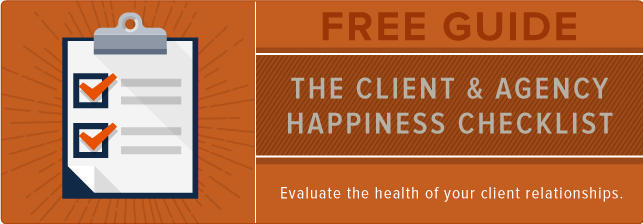
It’s inevitable: at some point, your client will give you the silent treatment. They probably don’t mean to make you blow steam from your ears -- it just happens -- and getting over the communication slump starts with walking a mile in their shoes.
It’s important to remember that many companies are understaffed and stretched thin. And even though studies show that burnout is bad for business, we see it happen all the time.
While it may be frustrating when you can’t get an answer from your client, it’s usually not the result of ill will or without reason. There’s a good chance your client lives in meetings for most of their days, leaving them with only a small window to take calls and answer emails. An empathic approach to your client relationships -- rather than an angry one -- will be better for both you and your client in the long run.
Why Clients Go Dark
There are several explanations for why your clients aren’t answering you. It could be as simple as email clutter. Haven’t we all tried to block off calendar time to clean out our inboxes, only to veer off course into this project or that phone call? We’re only human.
Experts say you need an entire minute to recover from reading a single email. And at bare minimum, you’d need three hours a day dedicated only to reading and sending emails if you were to stay completely caught up on your inbox. Your client might not have the bandwidth to sift through their inbox every day.
They could also be waiting on another department or team member to weigh in before they get back to you, and they just don’t have anything new to report. They could be putting out other fires they perceive as more important, or they could simply be stalling because they’re suffering from a bit of decision paralysis (again, it happens to the best of us).
Worst case scenario, they have bad news to deliver and they’re putting it off. But don’t jump to conclusions. While it’s normal for you to devote roughly 25 percent to 40 percent of your time to a project, clients usually devote only 5 percent to 10 percent of their time. Most likely, their lack of communication stems from the fact that they’re juggling a lot at once and are strapped for time.
The question is this: How do you move forward without feeling like you’re constantly nagging them?
Strategies for Breaking the Silence
It’s not easy to keep clients engaged when they’re seemingly tuning you out, but these simple strategies can help you stay in touch without hurting the relationship.
1) When setting deadlines, emphasize the most important ones.
If you assume your clients are going to miss any deadlines right out of the gate, you’re already planning ahead. Tell them upfront which deadlines are essential, and be firm about which will affect the success or timing of the project. If they’re going to forget something, it might as well be one of the less important somethings.
2) Be clear about the consequences of missing specific deadlines.
Don’t be afraid to put things in concrete terms: “If we don’t get X, we can’t make Y happen." This will light a fire in many clients right away because they don’t want to risk failure of their project. If you’re not clear about what you need from your client, you’ll end up taking the blame for missed deadlines yourself.
3) Don’t use calendar due dates.
Instead, set deadlines in number of days. For example, “Five workdays after we receive X, we can deliver Y." This creates a more visual timeline of what happens when even one small deadline is missed. It also gives your client a better understanding of the big consequences their lack of responsiveness can have on the project.
4) Get a structure in place for clear communication.
Agree on turnaround times and communication methods right away with your client. Ask if phone calls are better than emails. Maybe face-to-face meetings are more your clients’ style. Don’t assume that what works for you will work for them. If they have days they know are more hectic or they know they’ll be unavailable, make note of those, too.
5) Don’t end a meeting without scheduling a follow-up.
It’s kind of like getting a second date with someone you like: If you like someone, you shouldn’t hesitate to ask him or her out again. Go after your clients in a similar way. If you leave the schedule open-ended, you’ve just created another step you have to take to set it up later (and more messages for which you’ll have to wait for responses).
6) Create a ‘If we don’t hear from you’ plan.
Proactively ask your clients things like “How can we move this forward on our own, just in case we don’t hear from you?" It creates a backup plan right away, making it more likely that your deliverables and timeline can press onward. Plus, the more your clients can trust you to make decisions on their behalf, the stronger your relationships will become.
7) Get acquainted with your clients’ schedules.
When you want to escalate your communication urgency appropriately and respectfully, that might look very different if your client is having a “normal" week as opposed to being out of the office for a family reunion or vacation.
Get a sense of what your clients’ weeks typically look like so you can set reasonable deliverable dates. Making a “tell us about your week" question part of your usual status meetings with clients is a quick, easy way to anticipate issues and also understand what is reasonable and what might not be.
The Better You Understand Your Clients, The Easier It Becomes
From the agency’s perspective, an unresponsive client can squeeze the agency’s time to complete the project. Sometimes, a project has a fixed deadline, so no matter how the client delays the work, the agency still has to scramble to get it done. It can also lead to rush charges or other unnecessary expenses. But think of client silence this way: You should always be seeking to understand your customers better anyway, and unresponsiveness is yet another opportunity to do just that. Getting through this slump could be just the thing to bring you closer together.
from HubSpot Marketing Blog http://blog.hubspot.com/marketing/handle-unresponsive-clients
Via http://blog.hubspot.com/marketing/handle-unresponsive-clients

No comments:
Post a Comment